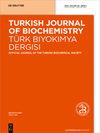高效环保生物吸附剂班加兰糖对Cu (II)离子的生物吸附研究
IF 0.7
4区 生物学
Q4 BIOCHEMISTRY & MOLECULAR BIOLOGY
Turkish Journal of Biochemistry-turk Biyokimya Dergisi
Pub Date : 2014-01-01
DOI:10.5505/TJB.2014.25483
引用次数: 2
摘要
目的:研究以蔗糖(Saccharum bengalense,简称SB)为原料制备的低成本生物吸附剂,用于去除水中的Cu (II)离子。方法:采用间歇式吸附法对铜离子进行生物吸附去除。结果:在初始pH 6.0条件下,在批量试验条件下,铜的去除率接近90%。采用Langmuir, Freundlich和Dubinin-Radushkevich (D-R)等温线描述了SB对Cu (II)的生物吸附,发现SB对Cu (II)的生物吸附符合Langmuir和Freundlich模型。通过Langmuir等温线在40℃时对SB的单层吸附量在323K时为10.42 mg/g。采用拟一级和拟二级动力学模型对Cu (II)吸附数据进行了分析。采用颗粒内扩散模型对速率决定步骤进行了研究。发现SB对Cu (II)离子的吸附符合准二级速率动力学。分别计算了吸附过程的自由能变化(ΔG°)、焓变化(ΔH°)和熵变化(ΔS°)等热力学参数,揭示了吸附过程的自发性、可行性和吸热性。结论:生物吸附剂SB是一种经济、环保的脱除水中Cu (II)的生物吸附剂。本文章由计算机程序翻译,如有差异,请以英文原文为准。
Biosorption Studies For Removal of Cu (II) ions Onto Saccharum Bengalense an Efficient and Eco-Friendly Biosorbent
Objective: In this research work, a low-cost biosorbent derived from the pulp of Saccharum bengalense (SB) was used as an adsorbent material for the removal of Cu (II) ions from aqueous solution. Methods: A batch adsorption method was experimented for biosorptive removal of copper ions from the aqueous solution. Results: Nearly 90% removal of copper is possible at initial pH 6.0, under the batch test conditions. Langmuir, Freundlich and Dubinin–Radushkevich (D–R) adsorption isotherms have been applied to describe the biosorption of Cu (II) by SB. It was found that biosorption of Cu (II) by SB followed Langmuir and Freundlich model. The monolayer adsorption capacity of SB as obtained from Langmuir isotherm at 40 0C was found to be 10.42 mg/g at 323K. The Cu (II) adsorption data was analyzed by applying pseudo-first-order and pseudo-second-order kinetic models. The intraparticle diffusion model was applied to investigate the rate-determining step. It was found that the biosorption of Cu (II) ions on SB followed pseudo second-order rate kinetics. Thermodynamic parameters such as free energy change (ΔG°), enthalpy change (ΔH°) and entropy change (ΔS°) have been calculated respectively revealed the spontaneous, feasible and endothermic nature of adsorption process. Conclusion: The results of the present investigation suggested that biosorbent SB can be used as an economically feasible and environmentally friendly biosorbent for the removal of Cu (II) from aqueous solutions.
求助全文
通过发布文献求助,成功后即可免费获取论文全文。
去求助
来源期刊
CiteScore
1.20
自引率
0.00%
发文量
0
审稿时长
6-12 weeks
期刊介绍:
Turkish Journal of Biochemistry (TJB), official journal of Turkish Biochemical Society, is issued electronically every 2 months. The main aim of the journal is to support the research and publishing culture by ensuring that every published manuscript has an added value and thus providing international acceptance of the “readability” of the manuscripts published in the journal.

 求助内容:
求助内容: 应助结果提醒方式:
应助结果提醒方式:


